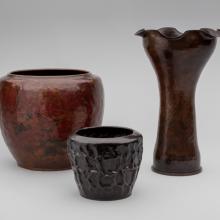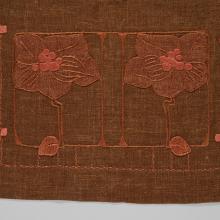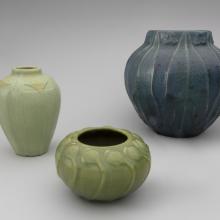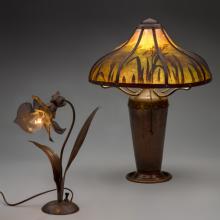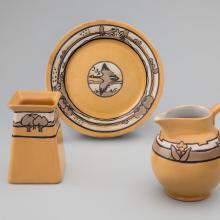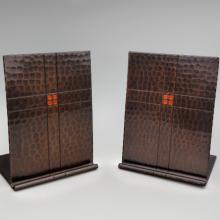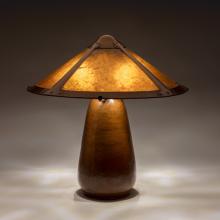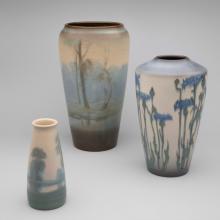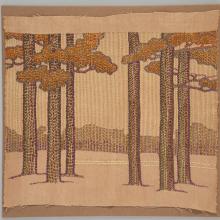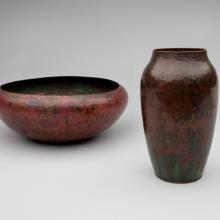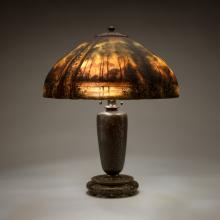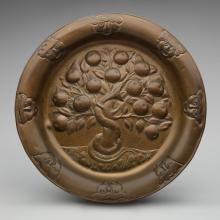International Terminal












Warty jardinière c. 1917 | Wrinkled warty vase c. 1912 | Shell casing vase c. 1908 |
Master craftsman Dirk van Erp (1862–1933) immigrated to the United States from the Netherlands in 1890. He soon settled in San Francisco where he worked for the Union Iron Works. Later on, he worked as a coppersmith in Vallejo at the Mare Island Naval Shipyard. During his free time, he began crafting vases using artillery shell casings. Within a couple of years he started selling them to an art gallery in San Francisco. In 1907, van Erp left the shipyard and was working full-time on his copper work. He later opened the Art Copper Shop in Oakland before leaving to form a new partnership in San Francisco in the fall of 1909 with the metalworker Elizabeth Eleanor D’Arcy Gaw (1868–1944). In 1910, the two designed the Dutch windmill mark that identified their work. Although the partners disbanded in 1911, Gaw left a lasting influence on van Erp’s work.
Many notable Bay Area coppersmiths received their start while working in van Erp’s shop, such as his nephew August Tiesselinck (1890–1972) and Harry St. John Dixon (1890–1967)— both would eventually leave van Erp’s workshop and later return. During World War I, all three men went to work for the Union Iron Works in San Francisco. Van Erp’s two children, Agatha and William, who also became noteworthy coppersmiths, maintained the shop during the war. When van Erp retired in 1929, his son William took over the business.
Magnolias table scarf c. 1910
Gustav Stickley Company
Syracuse, New York
fabric, embroidery floss
Courtesy of Dianne Ayres & Tim Hanson - Arts & Crafts Period Textiles
L2017.0206.005
Gustav Stickley (1858–1942), leading proponent of the American Arts and Crafts movement in the United States, was born to first-generation, German-immigrant parents in Wisconsin. Stickley established a business with his brothers before founding his own furniture business, the Gustav Stickley Company, in Syracuse, New York, in 1898. In 1901, Stickley launched The Craftsman periodical, which promoted Arts and Crafts nationwide in addition to touting his products. The publication included a variety of instructional articles for all types of craftwork. Although Stickley is largely known for the oak furniture he created, he also offered metalwork and textiles. Stickley’s textiles for Arts and Crafts interiors ranged from embroidered, appliquéd, and stenciled table scarves to wall hangings, curtains, pillows, and bedspreads.
Rather than drape entire surfaces with fabric, a common practice at the time, Arts and Crafts designers, including Stickley, encouraged people to drape single table scarves off-center across dining tables, which brightened austere wooden surfaces. Library tables, sideboards, and chests of drawers were also draped with scarves.
Vase with poppy motif 1905 | Poppy pods vase c. 1906 | Vase 1906 |
Artus Van Briggle (1869–1904) joined Rookwood Pottery in 1887 where he worked as a designer. While at Rookwood, the talented artist was sent to Paris to study from 1893 to 1896 where he first encountered Ming dynasty dry-matte glazes. After Van Briggle returned from France, he began experimenting with his own matte glazes. However, in 1899, plagued by tuberculosis, he moved to Colorado Springs; in 1901, he established a pottery there. With the help of his wife Anne Gregory Van Briggle (1869–1929) and a small staff, they crafted molded ceramics, with organic motifs or shapes, which exhibit Van Briggle’s magnificent matte glazes. Following Van Briggle’s untimely death in 1904 at the age of thirty-five, his wife Anne successfully managed the pottery until 1912. The highly acclaimed pottery received numerous awards at a number of expositions including the 1903 Paris Salon and the 1906–1907 Boston Arts and Crafts Society Exhibition. Van Briggle Pottery remains active today.
Flower lamp c. 1907 | Lamp with painted shade 1910 |
Lillian Palmer (1871–1961) and her family moved from St. Louis to San Jose around 1890. Undeterred by a lack of formal training, in 1907 Palmer began crafting metalwork in copper, lead, and brass fulltime. Her style exudes an unmistakably feminine quality that distinguishes her work from her contemporaries. Palmer garnered significant attention after being featured in the San Francisco Call in April of 1907, which detailed how the “Ingenious Girl Worker in Metals” devoted her daylight hours to fashioning beautiful, quality objects. Elizabeth Eleanor D’Arcy Gaw (1868–1944) assisted Palmer in her San Jose studio before she began working with Dirk van Erp (1862–1933) in 1909.
In 1908, Palmer embarked on a seven-month trip to Europe and Japan with her lifelong companion, architect Emily E. Williams (1869–1942). While in Vienna, Palmer studied metal crafting and design for electrified objects. After her trip, Palmer went to Chicago to study electrical engineering, learning how to make fixtures that consumed minimal amounts of power.
In 1910, Palmer opened The Palmer Copper Shop in San Francisco where she focused on making electric lamps and lighting fixtures, still a novelty at the time. Distinguished coppersmiths Harry St. John Dixon (1890–1967) and August Tiesselinck (1890–1972), who had both previously worked for Dirk van Erp, worked in Palmer’s shop for a number of years. Metal became scarce with the onset of World War I; by 1917, Palmer had no choice but to close her shop. She returned to metalwork after the war and in 1932 moved with Williams to Los Gatos, California.
Square vase with trees 1919 | Duck plate 1924 | Floral pitcher 1919 |
The Saturday Evening Girls Club began as a library reading group under the guidance of librarian Edith Guerrier (1870–1958) in Boston’s North End in 1899. The intent of the club was to improve the lives of mostly Italian and Jewish immigrant girls living in local, congested tenements. As the popularity of the group increased, Guerrier expanded the club, dividing it into different age groups and offering extracurricular activities. The success of these groups attracted the attention of philanthropist Helen Osborne Storrow (1864–1944), who helped establish Paul Revere Pottery in 1908.
Artist and illustrator Edith Brown (1873–1932), the director and head designer of Paul Revere Pottery, developed the ceramic’s playful imagery—stylized animals, birds, flora, and rustic scenes outlined with heavy black lines. Admired for its simplicity and charm, the ceramics could be personalized with names and initials. Club members made and decorated pots, looked after the workrooms, and staffed the retail store.
True to the Arts and Crafts ideals, and in contrast to the dismal factory conditions of the day, the workrooms at Paul Revere Pottery were clean, bright, and accented with flowers. Women received higher wages than those of the average factory worker and maintained shorter hours. Volunteers read literature or played music to women while they worked. New staff members learned by assisting more experienced workers, and artists were permitted to sign their pieces.
Bookends c. 1900–15
Roycroft
East Aurora, New York
hand-hammered copper
Courtesy of Kris Steensma
L2017.0203.030a,b
Entrepreneur Elbert Green Hubbard (1856–1915), who made his fortune in the soap business, founded Roycroft in East Aurora near Buffalo, New York, in 1894. The Roycroft community produced some of the finest furniture, books, lamps, and metalwork of the Arts and Crafts movement. Inspired by the work of Englishman William Morris, Hubbard’s progressive enterprise grew out of the initial success of his print shop and bindery. Roycroft’s use of its logo on many of its products lent a decorative effect. In addition to distributing a mail-order catalog, he published a magazine called The Philistine. Like The Craftsman, it contained Hubbard’s interpretations of Arts and Crafts ideals and helped popularize his products.
As Roycroft grew, Hubbard set up a community where artisans and their families lived and worked, coupled with a farm to help sustain his campus. Hubbard established lectures, concerts, and other activities for guild members and visitors to Roycroft. At its peak around 1915, nearly five hundred people worked at Roycroft. Because so many came to see the flourishing guild of artisans and workshops, Hubbard built the Roycroft Inn in 1903 to house guests. A number of talented artisans worked at Roycroft, particularly Dard Hunter (1883–1966), whose designs helped shape the distinctive look of Roycroft’s decorative arts. Metalworker and former banker Karl Kipp (1882–1954), head of the copper shop, also had a long-lasting influence on Roycroft’s metalwork.
Lamp c. 1912
Dirk van Erp (1862–1933)
San Francisco
hand-hammered copper, mica shade
anonymous lender
L2017.0201.009
Born in the Netherlands, Dirk van Erp (1862–1933) learned his trade in his homeland from his father, who ran a coppersmith shop with forty employees, crafting utensils for dairies. In 1893, a few years after arriving in America, he married Mary Ann Richardson (1867–1933). Prior to becoming the leading coppersmith of the Arts and Crafts movement, van Erp opened a plumbing business in Benicia, California, that quickly floundered. Before long, he ventured to Alaska for several months in search of gold during the Klondike Gold Rush.
In his mid-forties, nearly two decades after coming to America, he established the most prolific copper shop in the Bay Area on Sutter Street in San Francisco. Van Erp was especially known for his table lamps, which suited Arts and Crafts interiors in their refined simplicity. Their richly colored, hand-hammered copper bases complemented the mica shades, which radiated a warm, amber glow when lit. His workshop also offered a variety of hand-worked items, from vases to candlesticks, bookends, and fireplace settings.
Small scenic vase 1924 | Large scenic vase 1916 | Vase with flowers 1916 |
Maria Longworth Nichols (1849–1932) founded Rookwood Pottery in Cincinnati, Ohio, in 1880. Before long, it became the largest and most influential pottery in the country. Longworth named the pottery after the country estate of her father, Joseph Longworth. Longworth’s wealthy father also provided the funds to establish the pottery. A number of talented employees worked for Rookwood, such as leading ceramicist Artus Van Briggle (1869–1904), who remained at the firm for over a decade before leaving to found his own pottery in Colorado. Chemist Karl Langenbeck (1861–1938) and Mary Louise McLaughlin (1847–1939), who founded the Cincinnati Women’s Pottery Club in 1879, also worked at Rookwood. The pottery incorporated a variety of themes, such as Asian and floral motifs. Rookwood produced large numbers of ceramics in the Arts and Crafts, Art Nouveau, and later Art Deco styles. In addition to hand-painted decoration, many of its Arts and Crafts-style pieces were carved and decorated with plants, flowers, and sea creatures and feature bright, thick glazes. The pottery sold wares at its Cincinnati showroom and at department stores throughout the country.
Tree embroidery textile 1903–10
attributed to Newcomb College
New Orleans
fabric, embroidery floss
Courtesy of Dianne Ayres & Tim Hanson - Arts & Crafts Period Textiles
L2017.0206.019
Although best known for its pottery department, the H. Sophie Newcomb Memorial College was also acclaimed for its embroidery department, which opened in 1902. Unlike pottery, needlework had long been an entirely feminine craft. Most women learned how to do some form of needlework at an early age from their mothers. In pottery, men commonly shaped the pieces while women did the decorating. Needleworkers on the other hand, were responsible for their embroideries from start to finish. Artisans crafted designs for textiles in a similar fashion to ceramics, with designs first sketched in pencil and then rendered in watercolor. A variety of indigenous flora served as a major source of inspiration. Pieces of Newcomb embroidery, such as this tree panel, are extremely rare today.
Bowl with multi-color red patina c. 1920–25 | Vase with blue-green patina c. 1920–25 |
Harry St. John Dixon (1890–1967), brother of the artist Maynard Dixon (1875–1946), became one of the San Francisco Bay Area’s renowned coppersmiths. Born in 1890 in Fresno, California, Dixon (1890–1967) soon moved to San Francisco with his family. He met Dirk van Erp (1862–1933) in 1908 at an Arts and Crafts exhibition. The following year, he enrolled in the California School of Arts and Crafts in Berkeley (now California College of the Arts in Oakland) where he took a metalworking course. Dixon began working for Dirk van Erp in 1909, where he “really learned how to work metal.” He then worked for Lillian Palmer (1871–1961) from approximately 1912 to 1917. Dixon also taught at the California School of Arts and Crafts over the years.
In 1920, Dixon opened his own shop near Union Square in San Francisco. He employed about six people making jewelry and doing metalwork. Dixon’s shop also allegedly served as a gathering place for artists, writers, and fellow craftspeople. Dixon closed his shop in 1932 and again worked for the van Erps where he paid them a percentage of his profits. During World War II, Dixon returned to the same San Francisco shipyard in which he had worked during World War I. Harry St. John Dixon died in 1967 in Santa Rosa, California.
Lamp with painted shade c. 1915
Handel Lamp Company
Meriden, Connecticut
brass, glass, paint
Courtesy of Alan Schneider, The Antique Traders, San Francisco
L2017.0209.001a,b
Founded in 1885, the Handel Lamp Company was the preeminent maker of reverse-painted lamps, in which the shades’ interiors were hand-painted. Handel produced many lamps inspired by the Arts and Crafts movement and Art Nouveau. These styles began to wane after World War I, resulting in the closing of Handel in 1936.
Round platter c. 1910
England
hand-hammered brass
Courtesy of Maxine Risley
L2017.0205.010
The Arts and Crafts movement encouraged the involvement of amateurs and students as well as professionals. Organizations, such as the Home Arts and Industries Association in Great Britain, strove to promote and teach traditional handicrafts. Decorative metal projects featured in magazines included instructional tips and designs that could be copied.
Repoussé encompasses the centuries-old technique of creating motifs in metalwork by fine hammering on the surface’s opposite side. Repoussé appears on a variety of charming objects made by amateurs and students as well as master craftsmen. Pewter, brass, copper, and bronze were commonly employed.
